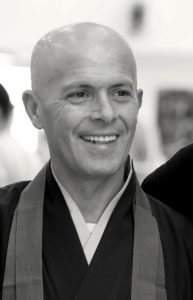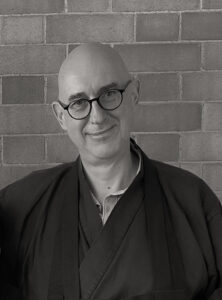This post is also available in:
Français
Italiano
Deutsch
Nederlands
The members of the board of directors of the non-profit association “Ecole Internationale de Sumi-e”, who also form the teaching, administrative and logistical team.
From left to right: Ariane, secretary, disability advisor and teacher, Alessandro, vice-president and teacher, Mauro, treasurer, Sonja, vice-treasurer, Beppe, honorary president, Zen and sumi-e master and teacher, Beatrice, administrator, Emi, vice-secretary and disability advisor, Alain, president and teacher.
School teachers

Beppe Mokuza
Honorary Chairman of the School.
Beppe Mokuza is a monk belonging to the Sôtô Zen Buddhist tradition, and a disciple of Zen Master Roland Yuno Rech. He is founder of the Bodai Dojo in Alba, northern Italy. For 30 years he has dedicated his life to sumi-e and the practice of Zen meditation, exhibiting his work and giving lectures throughout Europe. Since setting out on his journey, Beppe Mokuza has combined the practice of Zen meditation with that of sumi-e painting.
To discover Beppe Mokuza: http: //sumi-e.fr
Alain Keigyo Plaignaud
President of the School.
Alain Plaignaud has been practicing Zen meditation since 2007, and met Beppe Mokuza on this occasion in 2013. In 2017 he interrupted his career as an engineer to devote himself fully to the practice of sumi-e and Zen meditation. In 2023 he became a Zen monk.


Alessandro Doryu Sarrotto
Alessandro Doryu Sarotto is a sumi-e instructor. For 18 years, he has been studying under master Beppe Mokuza, assisting him with seminars, organizing exhibitions, and teaching courses throughout Europe. Responsible for teaching sumi-e in Italy, he organizes workshops for young people and adults throughout the country.
Ariane Eigen Mercier
Ariane Eigen Mercier is a Zen nun. At the age of 18, she moved to Italy to learn sumi-e and practice zazen with her master Beppe Mokuza Signoritti. After 15 years of daily training, she now teaches with great pleasure to all those who wish to take a few steps on this Path.

School indicators
The School’s activities consist of a 4-year certification program, with validation of prior learning at the end of each year, and occasional internships that are not part of a certification program.
See the School page for more details on the School’s activities.
It should be noted that the annual duration of the curriculum depends on the beneficiaries, who may not attend all the courses and therefore extend the calendar duration.
Beneficiaries not enrolled in the curriculum attend the entire course for which they are registered, without interruption, i.e. 5 or 9 days depending on the course.
The School’s activities began at the start of the 2019 school year.
Data are updated annually, at the end of the first half-year N+1, for year N.
The number of candidates taking the final exam and the number of certifications is Not Applicable (N/A) as long as no beneficiary has completed the 4-year course.
| Indicator | Sources | Method |
|---|---|---|
| Number of beneficiaries | Attendance records | Total number of training enrollments over one year. |
| Number of new beneficiaries | Attendance records | Same as beneficiaries never previously registered |
| Bounce rate | Attendance records | Ratio of cumulative enrollments in new training programs over a year / number of beneficiaries |
| Attendance rate | Attendance records | Ratio of number of hours of attendance / number of hours scheduled in registrations |
| Calendar duration | Attendance records | Average interval between the start date of the course and the end date in the year in months |
| Satisfaction rate | Evaluation forms | Average over one year of scores given by beneficiaries on items scored from 1 to 5: |
| – Practical contribution. | ||
| – Theoretical contribution. | ||
| – Personal development. | ||
| – Quality of practical information. | ||
| – Suitability of dates location and duration. | ||
| – Quality of the room catering and accommodation (if relevant). | ||
| – Teaching quality of the instructors | ||
| – Suitability of workshop topics. | ||
| Number of dropouts during the course of the year | Annual summary | Total number of students leaving the program during the year before the final exam |
| Number of dropouts during the course | Annual summary | Same after the annual exam |
| Success rate | Annual summary | Total number of candidates for the annual exam approved by the jury over the course of a year / number of candidates who took the exam |
| Number of candidates | Annual summary | Number of candidates for the final exam of the program |
| Number of certifications | Annual summary | Number of candidates for the final exam of the course validated by the jury |
Figures by year
Year 2019-2020
| Indicator | Category | Value |
|---|---|---|
| Number of beneficiaries | Curriculum | 5 |
| Outside the curriculum | 15 | |
| All | 20 | |
| Number of new beneficiaries | Curriculum | 5 |
| Outside the curriculum | 15 | |
| All | 20 | |
| Bounce rate | Curriculum | 0% |
| Outside the curriculum | 27% | |
| All | 20% | |
| Attendance rate | Curriculum | 93% |
| Outside the curriculum | 100% | |
| All | 97% | |
| Calendar duration | Curriculum | 10.5 months |
| Satisfaction rate | All | 93% |
| Number of dropouts during the academic year | Curriculum | 1 |
| Number of dropouts during the program | Curriculum | 4 |
| Success rate | Curriculum | 100% |
| Number of applicants | Curriculum | N/A |
| Number of certifications | Curriculum | N/A |
Withdrawals :
- 20% in financial difficulties
- 20% disagree with teaching method
- 60% to relocate and start a new professional activity that is too demanding.
Year 2020-2021
| Indicator | Category | Value |
|---|---|---|
| Number of beneficiaries | Curriculum | 1 |
| Outside the curriculum | 25 | |
| All | 26 | |
| Number of new beneficiaries | Curriculum | 1 |
| Outside the curriculum | 22 | |
| All | 23 | |
| Bounce rate | Curriculum | 100% |
| Outside the curriculum | 24% | |
| All | 27% | |
| Attendance rate | Curriculum | 100% |
| Outside the curriculum | 100% | |
| All | 100% | |
| Calendar duration | Curriculum | 94% |
| Satisfaction rate | All | 105 mois |
| Number of dropouts during the academic year | Curriculum | 0 |
| Number of dropouts during the program | Curriculum | 1 |
| Success rate | Curriculum | 100% |
| Number of applicants | Curriculum | N/A |
| Number of certifications | Curriculum | N/A |
Withdrawals :
- 100% too much taken up by the professional activity as a result of structural changes in this activity.
Year 2021-2022
| Indicator | Category | Value |
|---|---|---|
| Number of beneficiaries | Curriculum | 2 |
| Outside the curriculum | 94 | |
| All | 96 | |
| Number of new beneficiaries | Curriculum | 2 |
| Outside the curriculum | 83 | |
| All | 85 | |
| Bounce rate | Curriculum | 50% |
| Outside the curriculum | 21% | |
| All | 22% | |
| Attendance rate | Curriculum | 90% |
| Outside the curriculum | 100% | |
| All | 95% | |
| Calendar duration | Curriculum | 108 mois |
| Satisfaction rate | All | 91% |
| Number of dropouts during the academic year | Curriculum | 0 |
| Number of dropouts during the program | Curriculum | 0 |
| Success rate | Curriculum | 100% |
| Number of applicants | Curriculum | N/A |
| Number of certifications | Curriculum | N/A |
Withdrawals: none.
Year 2022-2023
| Indicator | Category | Value |
|---|---|---|
| Number of beneficiaries | Curriculum | 3 |
| Outside the curriculum | 66 | |
| All | 68 | |
| Number of new beneficiaries | Curriculum | 2 |
| Outside the curriculum | 53 | |
| All | 55 | |
| Bounce rate | Curriculum | 67% |
| Outside the curriculum | 18% | |
| All | 20% | |
| Attendance rate | Curriculum | 93% |
| Outside the curriculum | 100% | |
| All | 96% | |
| Calendar duration | Curriculum | 102 mois |
| Satisfaction rate | All | 91% |
| Number of dropouts during the academic year | Curriculum | 0 |
| Number of dropouts during the program | Curriculum | 0 |
| Success rate | Curriculum | 100% |
| Number of applicants | Curriculum | N/A |
| Number of certifications | Curriculum | N/A |
Withdrawals: none.
Year 2023-2024
| Indicator | Category | Value |
|---|---|---|
| Number of beneficiaries | Curriculum | 7 |
| Outside the curriculum | 54 | |
| All | 61 | |
| Number of new beneficiaries | Curriculum | 3 |
| Outside the curriculum | 37 | |
| All | 40 | |
| Bounce rate | Curriculum | 100% |
| Outside the curriculum | 30% | |
| All | 33% | |
| Attendance rate | Curriculum | 62% |
| Outside the curriculum | 100% | |
| All | 81% | |
| Calendar duration | Curriculum | 107 mois |
| Satisfaction rate | All | 88% |
| Number of dropouts during the academic year | Curriculum | 1 |
| Number of dropouts during the program | Curriculum | 0 |
| Success rate | Curriculum | 100% |
| Number of applicants | Curriculum | N/A |
| Number of certifications | Curriculum | N/A |
Note on trainee attendance: the rate is impacted by:
1) one trainee dropping out during the year.
2) in agreement with the teaching team, one of the trainees postponed a large part of her year to the following year, to devote herself entirely to a professional project.
Withdrawals: 1.
Following a behavioral remark by the teaching staff.
Year 2024-2025
| Indicator | Category | Value |
|---|---|---|
| Number of beneficiaries | Curriculum | 7 |
| Outside the curriculum | 34 | |
| All | 41 | |
| Number of new beneficiaries | Curriculum | 0 |
| Outside the curriculum | 24 | |
| All | 24 | |
| Bounce rate | Curriculum | 100% |
| Outside the curriculum | 29% | |
| All | 41% | |
| Attendance rate | Curriculum | 53% |
| Outside the curriculum | 100% | |
| All | 76% | |
| Calendar duration | Curriculum | 10.3 month |
| Satisfaction rate | All | 90% |
| Number of dropouts during the academic year | Curriculum | 0 |
| Number of dropouts during the program | Curriculum | 0 |
| Success rate | Curriculum | 100% |
| Number of applicants | Curriculum | N/A |
| Number of certifications | Curriculum | N/A |
No dropouts.
100% of eligible trainees graduate (1).
